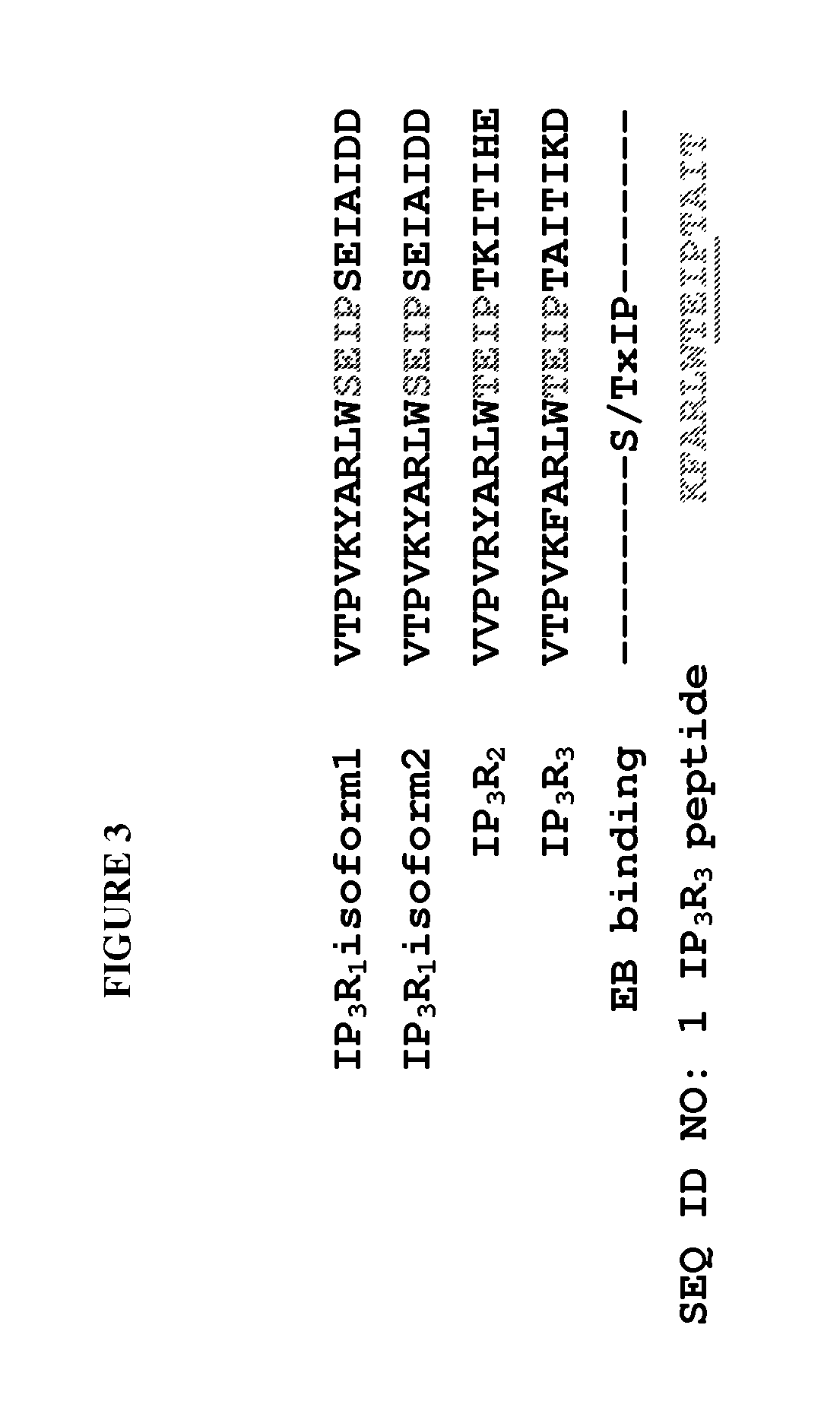Peptide compositions and methods for treating lung injury, asthma, anaphylaxis, angioedema, systemic vascular permeability syndromes, and nasal congestion
a technology of peptides and cytoskeleton elements, applied in the direction of peptide/protein ingredients, immunological disorders, extracellular fluid disorders, etc., can solve the problems of pulmonary edema, inconvenient drug use for doctors and their patients, and poor study of the role of this key cytoskeleton elemen
- Summary
- Abstract
- Description
- Claims
- Application Information
AI Technical Summary
Benefits of technology
Problems solved by technology
Method used
Image
Examples
example 1
Depletion of EB3 Inhibits Release of Ca2+ from Stores
[0079]Previous work suggested the role of the MT cytoskeleton in regulating IP3-gated release of Ca2+ from ER stores. The ability of EB3 to regulate release of Ca2+ from IP3-sensitive stores downstream of PAR-1 signaling was tested. It was determined that the changes in intracellular Ca2+ concentration in HMECs expressing shRNA to EB1, EB3 and Luciferase in response to PAR-1 activation (FIG. 1). Because our vector-based siRNA constructs were cloned into a GFP-C1 vector, we were able to compare the changes in non-transfected and transfected cell from the same coverslip. Depletion of EB1 did not have any effect on the release of Ca2+ from stores as compared to control non-transfected cells or cells expressing shRNA to Luciferase. In contrast, depletion of EB3 led to marked inhibition of Ca2+ release, thus resulting in decreased Ca2+ influx. The effect of simultaneous depletion of EB1 and EB3 was comparable with depletion of EB3 alon...
example 2
Role of EB3 Interaction with IP3R in the Mechanism of IP3-Gated Release of Ca2+
[0080]It was determined whether EB3 interacts with IP3R type 3, activity of which is critical for the thrombin-induced release of Ca2+ in ECs. Mice were challenged with sub-lethal dose of LPS and determined the association of EB3 with IP3R3 and TRPC1 (SOC) channel. As shown on FIG. 2, EB3 interacts with IP3R3 in resting endothelial microvasculature and the level of this interaction increases during LPS-induced lung inflammation. Interestingly, TRPC1 was also found in the EB3 precipitated in the lungs undergoing inflammation (3 hrs of LPS challenge). These changes were not observed in TLR4 (LPS receptor) KO mice indicating for causal relationship of these interactions and inflammation.
[0081]Interestingly, IP3R3 contains EB binding consensus motif, Ser / Thr-x-Ile-Pro (SxIP). A short peptide based on IP3R3 sequence (KFARLWTEIPTAIT—SEQ ID NO: 1) (FIG. 3) shows high binding activity for EB3 with free energy bin...
example 3
IP3R3 Peptide Prevents Inflammation-Induced Pulmonary Vascular Leakage and Lethality in Sepsis
[0082]To address the role of EB3 / IP3R interaction in regulating vascular endothelial permeability we used ex vivo lung preparations. The peptide was infused into lungs for 30 minutes prior to infusion of PAR-1 agonist peptide and the interaction between EB3 and IP3R3 was determined by IP assay (FIG. 6). Activation of PAR-1 receptor significantly increased the EB3 / IP3R3 interaction as compared to basal level whereas profusion of IP3R3 peptide inhibited this interaction in activated lung microvasculature. Consequently, IP3R3 peptide mitigated the increase in lung vessel permeability as measured by changes in microvascular filtration coefficient, Kf,c. FIG. 7 demonstrates that IP3R3 peptide markedly attenuates the increase in microvascular permeability in response to PAR-1 activation. These data suggest that interaction between EB3 and IP3R might be important for inflammation-induced vascular ...
PUM
 Login to View More
Login to View More Abstract
Description
Claims
Application Information
 Login to View More
Login to View More - R&D
- Intellectual Property
- Life Sciences
- Materials
- Tech Scout
- Unparalleled Data Quality
- Higher Quality Content
- 60% Fewer Hallucinations
Browse by: Latest US Patents, China's latest patents, Technical Efficacy Thesaurus, Application Domain, Technology Topic, Popular Technical Reports.
© 2025 PatSnap. All rights reserved.Legal|Privacy policy|Modern Slavery Act Transparency Statement|Sitemap|About US| Contact US: help@patsnap.com



